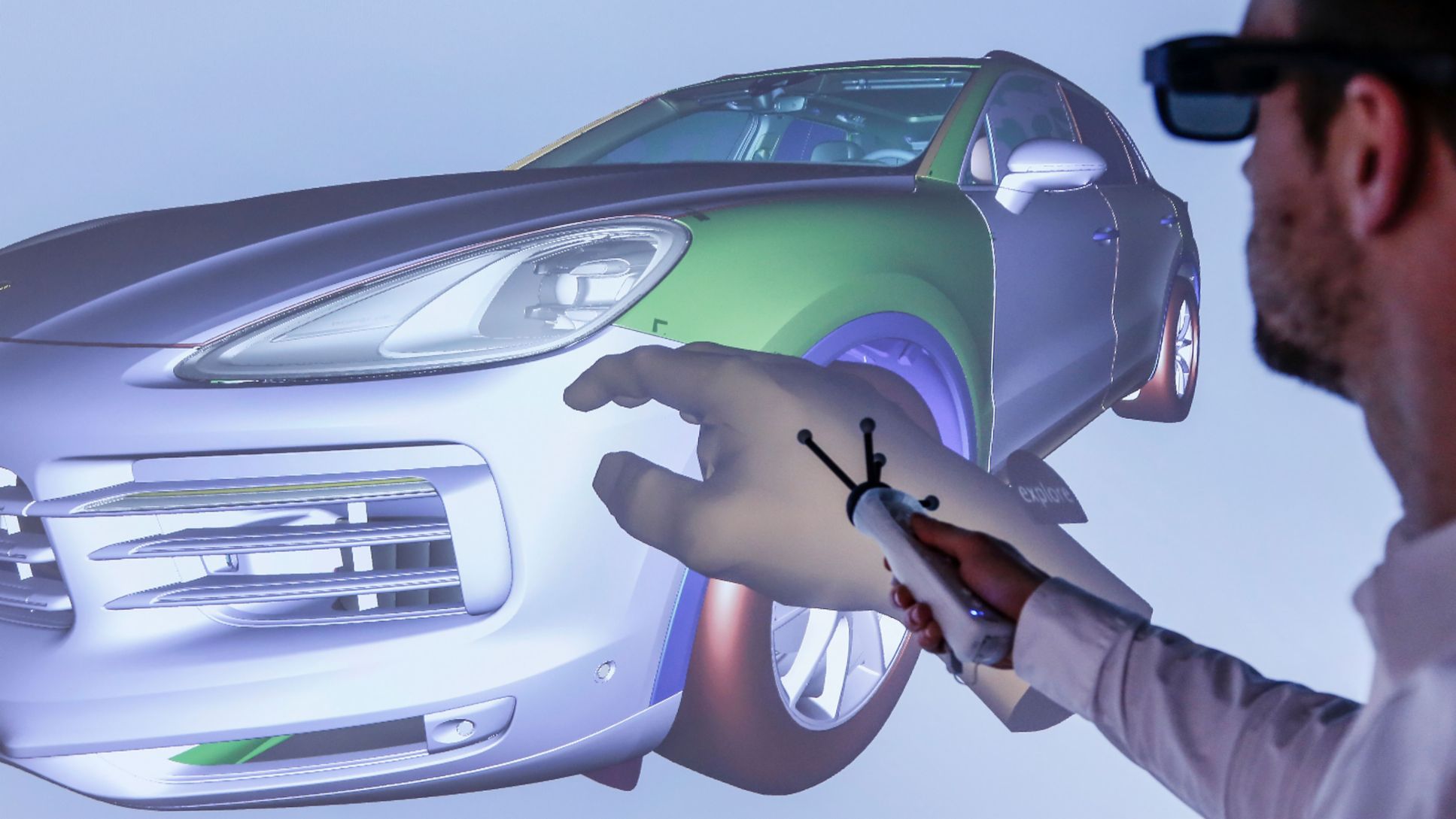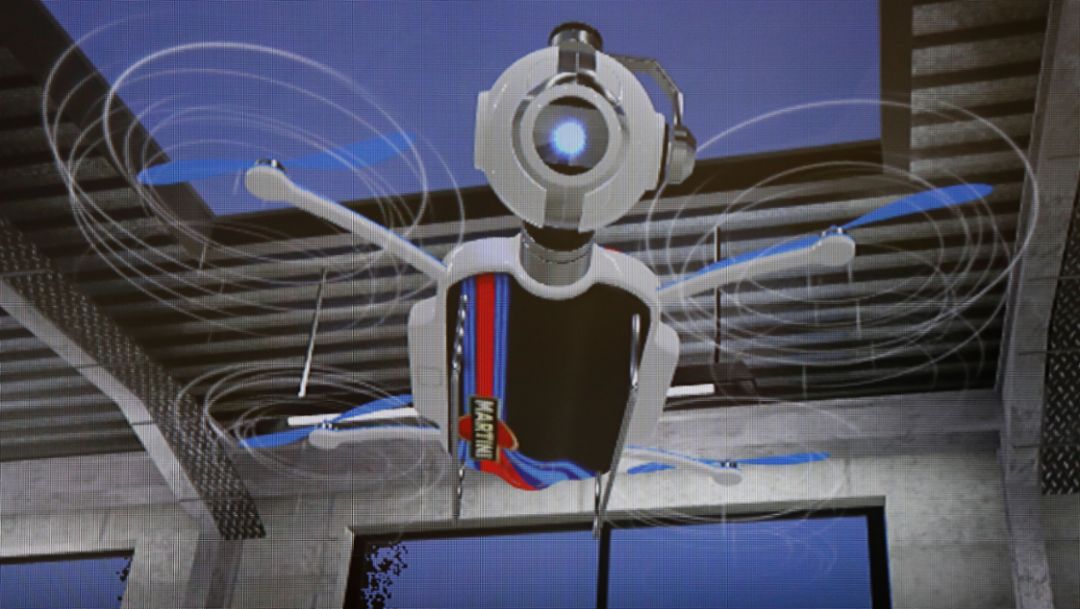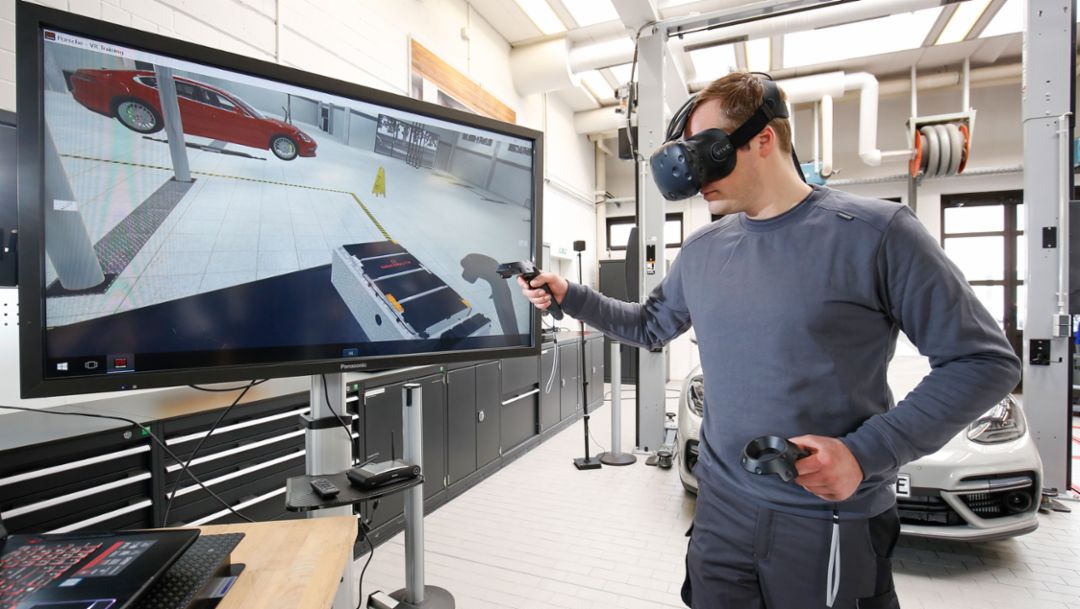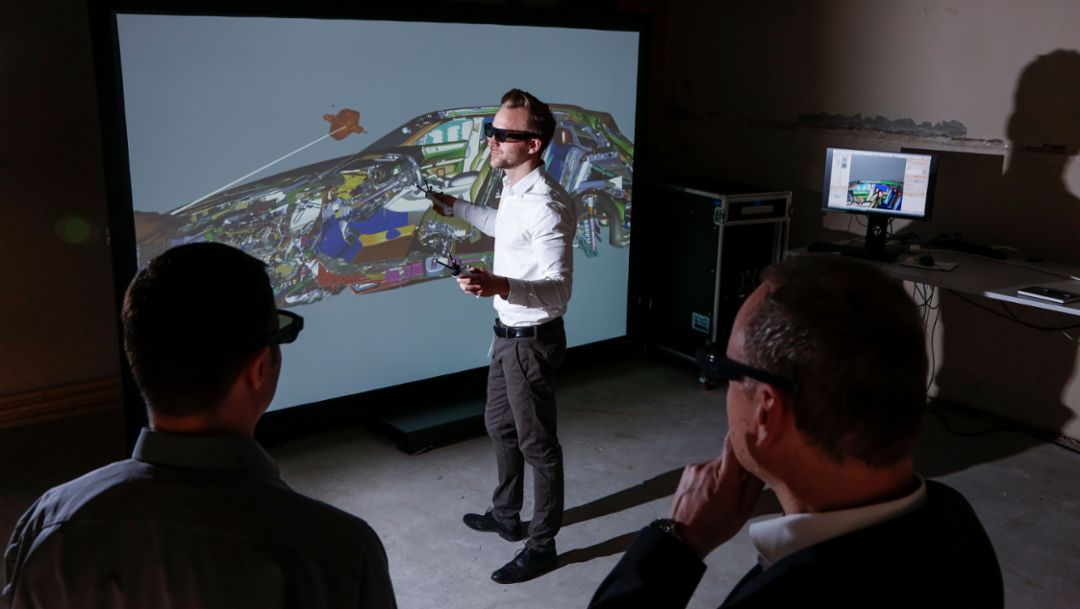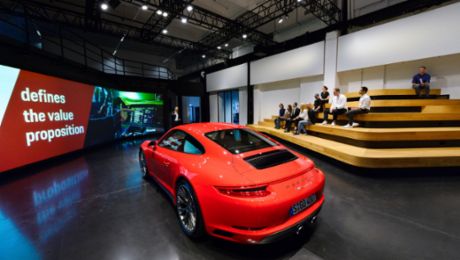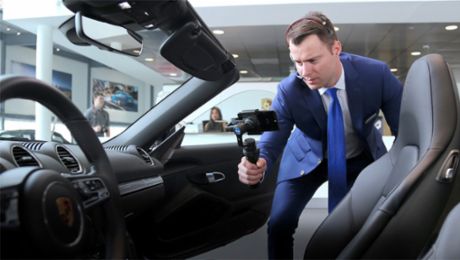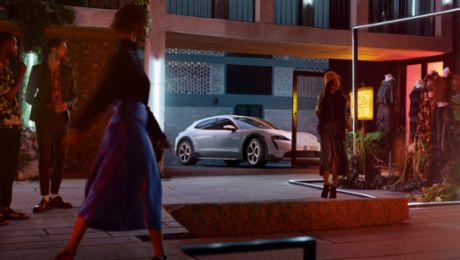The term “Power Wall” refers to another digital innovation in the field of sales: Detailed 3D models ensure that the concerns of After Sales staff can be incorporated into the product development process long before the first prototype parts are made.
“Ooops, it looks like there is an error in cell module number three”, says Alice without any trace of emotion. Alice is a drone. A very charming drone, it must be said. And the authentic Martini Racing design that decorates her exterior is a treat for the eyes. Alice is also intelligent and helpful. To cite just one example, she can guide mechanics through the individual steps needed to repair the high-voltage battery of the Panamera 4 E-Hybrid. With Alice supervising them every step of the way, each individual movement can be practised in complete safety. That’s because the training takes place in the virtual world. Alice can only be experienced if you are wearing VR glasses.
Super powers, X-ray vision and interaction with Alice
The After Sales department in Ludwigsburg is leveraging the possibilities offered by virtual reality to ready itself for the future. VR glasses are increasingly being used by technicians in all markets as an entirely new way of preparing for the more advanced instructor-led training. Super powers, X-ray vision and interaction with Alice are just some of the things awaiting anyone who puts on the VR glasses, picks up the controller and enters one of the virtual spaces. And these features make it possible to achieve highly effective training outcomes long before new vehicles come onto the market. “We’ve programmed a speaking drone to act as a personal assistant so people don’t get so lonely”, explains Christian Binder, Project Manager for New Qualification Media, introducing Alice.
The value of this new technology is apparent from a true-to-life 3D model of a Panamera 4 E-Hybrid that stands in the middle of a virtual (and otherwise empty) workshop hall. One click of the controller makes the bodywork disappear as if by magic, and the orange cables and high-voltage components hover mid-air in their installation locations. The first task is to take as much time as necessary to gain an overview of where the various modules in the electrified powertrain are located. The large 14.1-kWh lithium-ion battery at the rear of the vehicle can also be scrutinised from every angle. It doesn’t take long to get used to the controller, while the shifts in the line of vision follow the natural movements of the user’s head.
Marc Wörsching, one of Binder’s colleagues, updates us on the latest developments: “All of the trainers have already tested out the VR programme, and we’ve made changes in response to their feedback. The next step is to pilot the programme in our training centres”. A good example of content covered in the VR programme is the procedure for repairing high-voltage batteries. Topics such as these are prime candidates for early exposure before attending an instructor-led training course.
Christian Binder highlights another advantage of VR training: “The content we have identified as most important can be delivered directly to our technicians exactly as we intend, avoiding the ‘Chinese whispers’ effect we sometimes encountered previously. We were never sure if the recipients were seeing and hearing the right information”. As Project Manager, he is very clear about the core target group for VR training: “Around 8,000 technicians work in the Porsche Centres around the world. They are the people we want to reach with our new VR training programme”. The technical barriers that must be overcome before entering the world of virtual training are relatively low: VR glasses, and a powerful laptop so that the high-resolution graphics can be displayed smoothly.
Reduced waiting times: software replaces hardware
Now it’s time to change both the subject and the location. Special glasses – along with animated graphics – play a key role somewhere else in Porsche, namely the Department Aftersales - Technical Service - Product Engineering. Jonas Wutgen is the man responsible. With one hand resting on his computer mouse, he concentrates on the screen in front of him. He’s waiting for the data to load. A colourful cutaway model of a Cayenne appears on the “Power Wall” in front of him, which measures two by three metres. It’s time to get started by putting on special shutter glasses and taking hold of the controller. With just a few gestures, the Project Manager rotates the 3D model so that the side of the vehicle is visible. “Every part is reproduced here digitally – right down to individual bolts”, says Wutgen, emphasising the level of detail as he carefully navigates his way to the engine compartment. “We can simply select particular components and find out whether they can be dismantled or whether other components are in the way”. Technicians can use the virtual Cayenne to check whether there will be space in their real-life workshop to remove and install parts safely and to manoeuvre the necessary tools.
Assembly and disassembly tests used to have one thing in common – they involved hardware. After Sales employees could only practice the sequences of movements they would need for repair jobs when a prototype became available. And there was a problem: Over the years, the number of prototypes dropped, and even these were not always available at the right time. “We’re currently transitioning from hardware to software”, explains Wutgen, and demonstrates just how this happens on the Power Wall. “Repairs to individual vehicle components can now be practised using 3D data, without the need for a real-life prototype”.
Thomas Eckert, Manager Technical Service - Product Engineering, sums up the key advantage of this digitised process: “The digital simulation methods available to us with the Power Wall mean that we can intervene in the product development process at an earlier stage and, if necessary, work together with our colleagues in Development to make any changes”. Another advantage of digital prototypes over the real-life counterparts of the past is that everything is just a few clicks away – any configuration of equipment and any engine, for either right-hand or left-hand drive.
Virtual Vehicle department
Virtual assembly and disassembly simulations on the Power Wall are just one aspect of working with 3D data. After Sales employees meet on a regular basis in “tandem teams” to discuss repair concepts and the repair instructions partly based on these concepts. There are also plans to use the Power Wall for cross-Group and cross-brand studies in future. The highly detailed data for the 3D models is provided by the Weissach-based Virtual Vehicle department. Since the end of 2017, employees in Product Engineering After Sales have been using 3D technology for sales purposes – initially in a pilot project, before it becomes a standard feature of the development process for future series-production vehicles from the second half of 2018.
Consumption data
Panamera 4 E-Hybrid: Fuel consumption combined 2.5 l/100 km; CO2 emissions 56 g/km; electricity consumption (combined) 15.9 kWh/100 km
